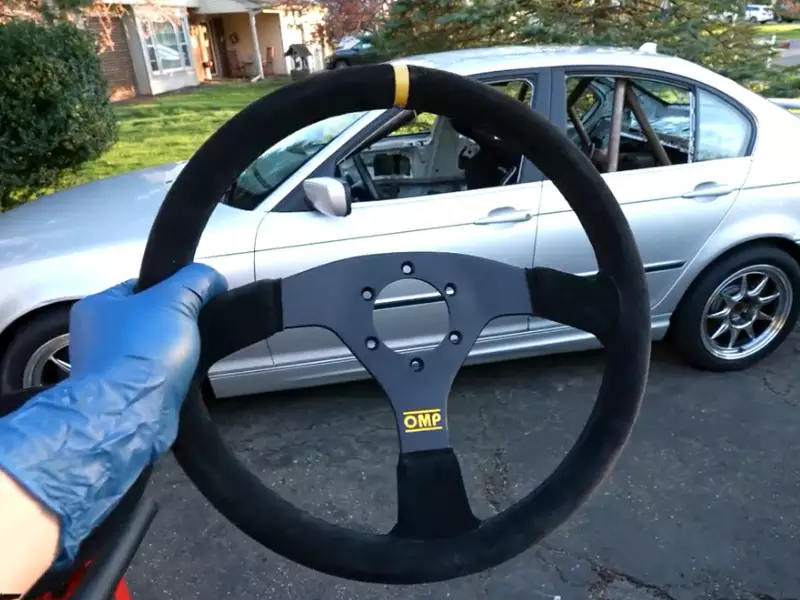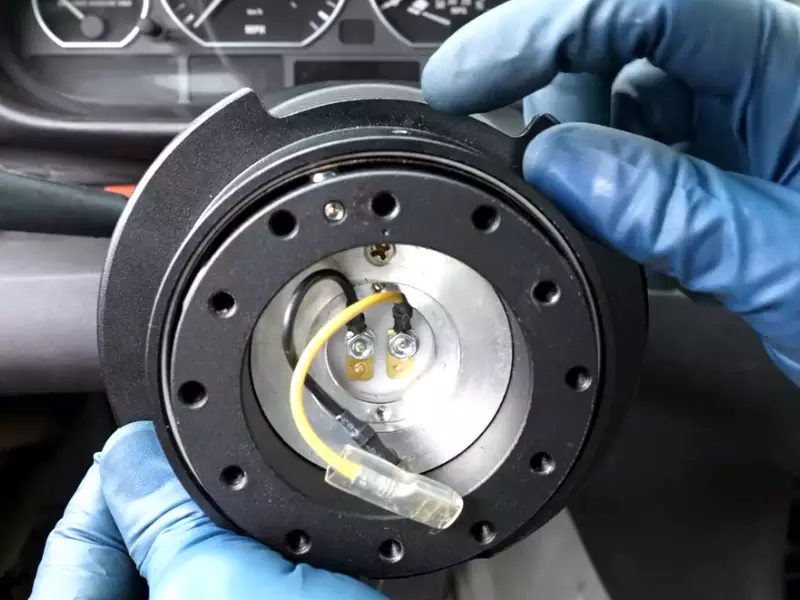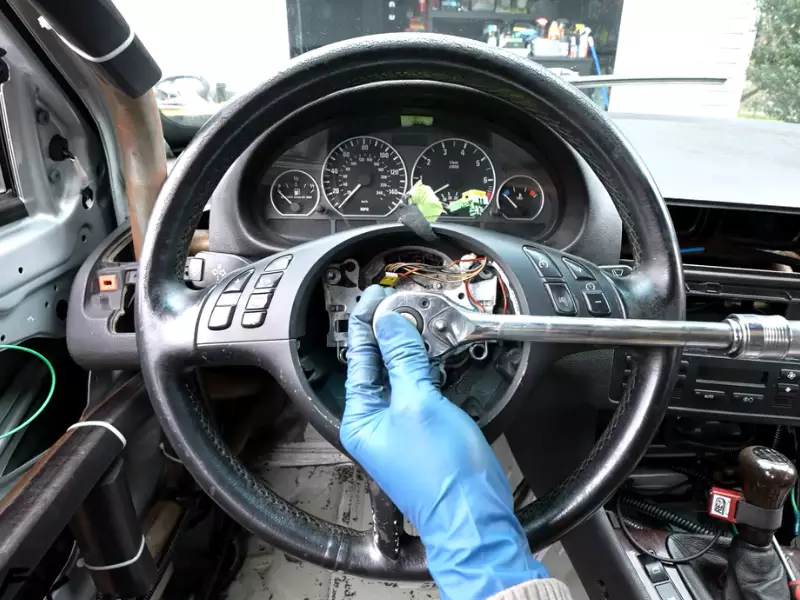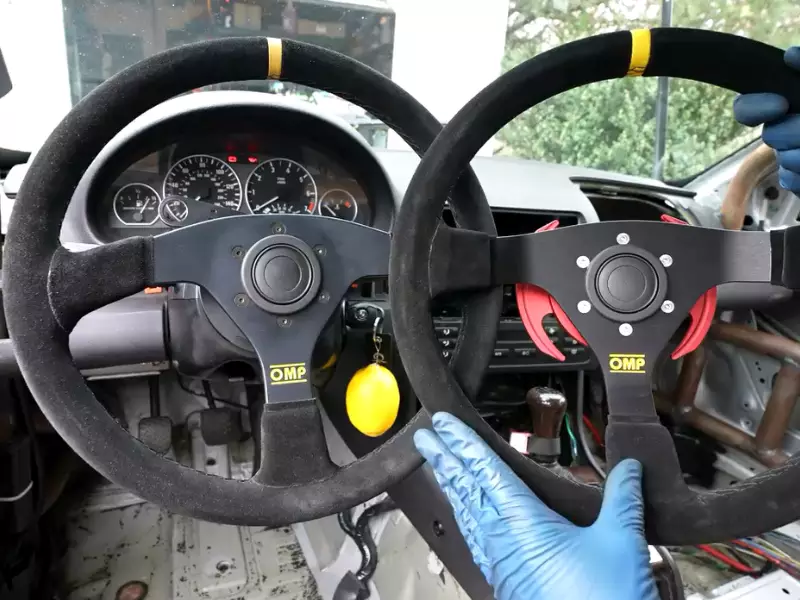To install a steering wheel, disconnect the battery, remove the old steering wheel, align the new wheel, and securely fasten it in place. Installing a steering wheel is a relatively straightforward process that can be done with basic tools and a little bit of patience.
Whether you want to replace a worn-out wheel or upgrade to a sportier model, following these steps will ensure a smooth installation. By taking the time to properly install your new steering wheel, you can enhance your driving experience and improve the overall appearance of your vehicle’s interior.
So, let’s dive into the step-by-step process of installing a steering wheel and get ready to hit the road with your newly installed wheel.

Choosing The Right Steering Wheel
When it comes to installing a new steering wheel, choosing the right one for your vehicle is crucial. Not only does it enhance the overall look of your car’s interior, but it also ensures a comfortable and secure driving experience. Here, we’ll discuss the important factors to consider when selecting a steering wheel, including the material and design options, as well as compatibility with your vehicle model.
Factors to Consider
Before purchasing a steering wheel, there are several factors you should take into account:
- Size: Different steering wheels come in various sizes, so it’s important to select one that suits your driving style and comfort. A larger wheel provides better handling and control, while a smaller one can enhance the sporty feel and responsiveness of your vehicle.
- Grip: The grip of the steering wheel is crucial for a safe and comfortable driving experience. Choose a wheel with a textured surface or ergonomic design that ensures a firm and secure grip, especially during tight turns or longer journeys.
- Functionality: Consider the additional features you may require, such as integrated controls for audio, cruise control, or even paddle shifters for a more sporty driving experience. These functionalities can improve convenience and accessibility, making your driving experience more enjoyable.
- Style: Your steering wheel is not only a functional component but also a style statement. Consider the overall interior design of your vehicle and choose a steering wheel that complements it. From classic leather designs to modern carbon fiber finishes, there are plenty of options to match your personal style.
Material and Design Options
The material and design of the steering wheel play a crucial role in both aesthetics and practicality. Some common options include:
- Leather: Steering wheels with genuine leather covers offer a luxurious look and a comfortable grip.
- Alcantara: This synthetic suede material provides a premium feel and enhanced grip, similar to authentic suede.
- Carbon fiber: Known for its lightweight and high-strength properties, carbon fiber steering wheels add a sporty and modern touch to your vehicle’s interior.
- Wood: For a classic and timeless appearance, wooden steering wheels are a popular choice, often seen in vintage and luxury cars.
Additionally, consider the design elements such as stitching patterns, color options, and shape of the steering wheel to ensure it complements your vehicle’s interior seamlessly.
Compatibility with Vehicle Model
Before finalizing your steering wheel choice, it’s important to ensure compatibility with your specific vehicle model. Steering wheels come in different hub patterns and sizes, so it’s essential to check the specifications and confirm that the wheel you choose fits your car’s make and model. For a precise fit and easy installation, consider purchasing a steering wheel specifically designed for your vehicle or consult with a professional installer who can guide you through the process.
Choosing the right steering wheel is more than just a matter of aesthetics. It impacts your driving experience, comfort, and overall control of your vehicle. By considering factors such as size, grip, functionality, style, and compatibility, you can find the perfect steering wheel that enhances both the look and feel of your car’s interior.

Tools And Equipment Needed
Installing a new steering wheel can give your car a fresh look and enhance your driving experience. However, before you get started, it’s important to gather the right tools and equipment to ensure a smooth installation process. In this section, we’ll outline the required tools and optional tools that can come in handy during the installation.
Required Tools
Here are the essential tools you’ll need to successfully install a steering wheel:
- Screwdriver set: A set of screwdrivers with different sizes and types will help you remove the existing steering wheel.
- Torque wrench: This tool is necessary to properly tighten the bolts that hold the new steering wheel in place.
- Steering wheel puller: In some cases, you may need a steering wheel puller to safely remove the old steering wheel from the steering column.
- Socket set: A socket set with various sizes will be handy for loosening and tightening bolts during the installation process.
- Wire cutters/strippers: If your steering wheel has electrical components such as audio controls, you may need wire cutters or strippers to disconnect the wiring.
- Wrench: A wrench will be necessary for removing and installing the steering wheel’s center nut.
- Protective gloves: Wearing gloves will help protect your hands during the installation process.
Optional Tools
While not essential, these optional tools can make the installation easier and more convenient:
- Flashlight: A flashlight can help you see better in dimly lit areas of the steering column.
- Trim removal tools: These tools are useful for safely removing the trim pieces surrounding the steering wheel.
- Electrical tape: Electrical tape can be used to secure and insulate any exposed wires during the installation process.
- Steering wheel cover: A steering wheel cover can protect the new steering wheel from wear and tear.
- Anti-seize compound: Applying an anti-seize compound to the steering wheel’s center bolt can prevent it from seizing over time, making future removal easier.
- Shop rag or towel: Keeping a shop rag or towel handy will help you clean any dirt or debris that may accumulate during the installation process.
By having these tools and equipment ready before you start, you’ll have everything you need to tackle the installation with confidence and ensure a successful outcome.
Preparing For The Installation
Before installing a new steering wheel, you need to gather necessary information, review the vehicle manual, and take certain precautions to ensure a smooth and safe installation process. Let’s dive into each step in detail:
Gather Necessary Information
Before you begin the installation, it’s essential to gather all the necessary information regarding your specific vehicle and the steering wheel you wish to install. Here are a few key pieces of information to collect:
- The make, model, and year of your vehicle: This will help you find the compatible steering wheel for your car.
- Diameter and spline count of the steering wheel: Measure the diameter of your current wheel to ensure the new one is a proper fit. Similarly, count the number of splines to match the replacement.
- The airbag system in your vehicle: Determine if your existing steering wheel has an airbag. This information will impact the installation process.

Review Vehicle Manual
Next, carefully review your vehicle’s manual to understand any specific instructions or precautions related to steering wheel installation. The manual will provide you with valuable insights into the removal and installation procedure for your particular vehicle make and model. Pay close attention to any steps specific to the airbag system, as mishandling it could lead to serious injury.
Disconnect Battery and Precautions
Prior to starting the installation, disconnecting the vehicle’s battery is crucial for safety reasons. This step is important to prevent accidental deployment of the airbag and potential electrical damage.
Follow these steps to disconnect your vehicle’s battery:
- Turn off the engine and remove the key from the ignition.
- Locate the battery in your vehicle. Refer to the vehicle manual if needed.
- Using the appropriate tools, loosen the negative terminal clamp first, followed by the positive terminal clamp. Be cautious not to touch both clamps together or any metal objects simultaneously.
- Tape or cover the disconnected terminals with an insulating material to prevent accidental contact.
Keep in mind a few additional precautions:
- Allow the vehicle to sit for about 10-15 minutes after disconnecting the battery to discharge any residual electrical energy.
- During the installation, avoid touching any electrical components or wires to prevent possible damage or injury.
- Wear gloves and safety goggles to protect yourself from any potential hazards.
By following these steps and precautions, you’re ready to move on to the installation process and enjoy your new steering wheel!
Removing The Old Steering Wheel
Removing the old steering wheel might seem like a daunting task, but with the right tools and a little know-how, it can be a straightforward process. This section will guide you through the steps required to safely remove the old steering wheel so that you can proceed with installing the new one.
Locate Airbag Components
Before you begin, it’s crucial to locate the airbag components. The airbag is an essential safety feature in your vehicle and must be handled with care during the steering wheel removal process.
To find the airbag components, refer to your vehicle’s user manual. The manual will provide detailed instructions on where the airbag components are located and how to identify them. It is essential to follow these instructions carefully to ensure your safety.
Disconnect Airbag
Once you have identified the airbag components, it’s time to disconnect the airbag. Disconnecting the airbag is a critical step to prevent accidental deployment and potential injury.
To disconnect the airbag, locate the electrical connector that connects the airbag to the wiring harness. Carefully detach the connector by gently pressing the release tab or using a suitable tool. Take extra care not to damage the connector or the wiring harness during this process.

Remove Steering Wheel Cover
Now that the airbag is disconnected, you can proceed to remove the steering wheel cover. The steering wheel cover is typically made of fabric, leather, or other materials and protects the steering wheel from wear and tear.
To remove the steering wheel cover, locate any clips or fasteners securing it to the steering wheel. Gently pry open the clips or remove the fasteners using a suitable tool. Slowly work your way around the steering wheel, releasing the cover until it is completely detached.
Once the cover is removed, take a moment to inspect its condition. If it is damaged or worn out, consider replacing it before installing the new steering wheel for a fresh and stylish look.
Congratulations! You have successfully completed the process of removing the old steering wheel. The next step is to install the new steering wheel, which we will cover in the following section. Stay tuned!
Installing The New Steering Wheel
Now that you have removed the old steering wheel successfully, it’s time to install the new one. Follow these steps to ensure a proper installation:
Aligning the Steering Wheel
To begin the installation process, make sure the vehicle’s wheels are pointing straight. This will help you align the new steering wheel correctly. Then, align the steering wheel itself so that it is centered and facing straight ahead. This step is important to ensure a balanced and comfortable driving experience.
Attaching the Steering Wheel
Once the steering wheel is aligned, it’s time to attach it to the steering column. To do this, locate the mounting holes on the back of the steering wheel and line them up with the corresponding holes on the steering column. Carefully slide the wheel onto the column, making sure it fits snugly.
Using a Steering Wheel Puller
If the new steering wheel doesn’t slide on easily, you may need to use a steering wheel puller to remove the old one completely. A puller is a tool designed to safely remove steering wheels by applying even pressure. Follow the manufacturer’s instructions when using a steering wheel puller to avoid any damage to the steering column or airbag system.
Securing with Bolts and Nuts
Once the steering wheel is in place, secure it using the provided bolts and nuts. Insert the bolts into the mounting holes on the steering wheel and tighten the nuts using a wrench. Make sure they are tightened evenly and securely to prevent any wobbling or movement of the steering wheel during driving.
With these steps completed, your new steering wheel should be securely installed and ready to use. Double-check the alignment once more to ensure a comfortable and safe driving experience.
Connecting The Horn And Other Electrical Components
When it comes to installing a steering wheel, one crucial step is connecting the horn and other electrical components. This ensures that your steering wheel functions properly and enables you to use all the necessary features while driving. In this section, we will go through the process of wiring the horn and connecting other components.

Wiring the Horn
To wire the horn, you’ll need a few tools like wire cutters, electrical tape, and a wiring diagram specific to your vehicle. Follow these steps:
- Before starting, ensure that the vehicle’s battery is disconnected to avoid any electrical hazards.
- Locate the horn button wire. This wire is usually located near the steering column or inside the steering wheel housing.
- Using the wire cutters, carefully strip the insulation off both ends of the horn button wire.
- Locate the horn wire that runs from the horn relay to the steering wheel.
- Connect one end of the horn button wire to the horn wire by twisting them together.
- Secure the connection by wrapping it with electrical tape.
- Repeat the process for the other end of the horn button wire, attaching it to the appropriate terminal on the steering wheel.
Finally, reconnect the vehicle’s battery and test the horn by pressing the horn button on the steering wheel. If you hear a sound, it means that the horn is properly wired and ready to use.
Connecting Other Components
Apart from the horn, there might be other electrical components that need to be connected when installing a steering wheel. These components can include cruise control, audio controls, or even airbag functionality. To ensure the proper connection, follow these general steps:
- Refer to your vehicle’s wiring diagram to identify the specific wires and components that need to be connected.
- Remove any existing connections or components from the old steering wheel, carefully disconnecting them.
- Connect the corresponding wires from the new steering wheel to the appropriate components.
- Secure the connections with electrical tape or connectors designed for automotive applications.
- Double-check all connections and make sure they are tight and secure.
Remember to refer to the manufacturer’s instructions or consult a professional if you are unsure about any specific connection. Safety is paramount when working with the vehicle’s electrical system, so take your time and ensure everything is properly installed before use.
By following these steps, you can successfully connect the horn and other electrical components when installing a steering wheel. This will enable you to enjoy all the necessary functions and features while driving, ensuring a comfortable and safe experience on the road.
Testing And Finalizing
Once you have successfully installed your new steering wheel, it’s important to perform a few tests to ensure it is working correctly. In this section, we will discuss how to reconnect the battery, test the steering wheel operation, and adjust the steering wheel position.
Reconnecting Battery
Before you begin testing the steering wheel, it’s crucial to reconnect the battery if you disconnected it during the installation process. This step ensures that the electrical components of your vehicle, including the steering wheel, have power. Here’s how you can reconnect the battery:
- Locate the battery: Open the hood of your vehicle and locate the battery. It is usually a rectangular box with two terminals.
- Identify the positive and negative terminals: The positive terminal is typically labeled with a plus sign (+), and the negative terminal is labeled with a minus sign (-).
- Attach the positive terminal: Take the positive (red) cable and attach it to the positive terminal. Ensure it is secure.
- Attach the negative terminal: Take the negative (black) cable and attach it to the negative terminal. Again, make sure it is secure.
- Tighten the terminal connections: Use a wrench or socket to tighten the terminal connections, ensuring they are snug but not overly tight.
- Close the hood: Lower the hood of your vehicle and ensure it is securely closed.
Testing Steering Wheel Operation
Now that the battery is reconnected, you can test the operation of your steering wheel. This step is crucial to ensure that your new steering wheel functions properly. Follow these steps to test the steering wheel operation:
- Sit in the driver’s seat: Take a comfortable position in the driver’s seat and ensure you are ready to start the vehicle.
- Insert the key: Insert the key into the ignition and turn it to start the vehicle.
- Start the engine: Turn the key further to start the engine. Listen for any unusual noises or vibrations.
- Rotate the steering wheel: Slowly rotate the steering wheel in both directions, checking for smooth operation.
- Test the horn: Press the horn button on the steering wheel to check if it sounds properly.
- Check indicator lights: Pay attention to any indicator lights on the dashboard related to the steering system. Ensure they are functioning correctly.
Adjusting the Steering Wheel Position
Once you have confirmed that the steering wheel is functioning correctly, you can proceed to adjust its position for optimal comfort and control. Follow these steps to adjust the steering wheel position:
- Locate the steering wheel adjustment lever: Look for a lever or handle typically located underneath the steering column or on the side of the steering wheel.
- Unlock the lever: Pull or push the lever to unlock the steering wheel adjustment.
- Adjust the steering wheel: Move the steering wheel up, down, or tilt it forward or backward as desired. Ensure it is in a comfortable position.
- Lock the lever: Once you have adjusted the steering wheel, push or pull the lever back to lock it in place.
- Test the new position: Sit in the driver’s seat and ensure that the newly adjusted steering wheel position provides the desired comfort and control.
By following these steps and conducting the necessary tests, you can confidently finalize the installation of your new steering wheel. Remember to take your time during the testing and adjustment process to ensure a safe and enjoyable driving experience.
Frequently Asked Questions On How To Install A Steering Wheel
Is It Hard To Replace A Steering Wheel?
Replacing a steering wheel is not a complex task. With the right tools and knowledge, it can be done easily. Ensure you follow proper instructions and take necessary safety precautions.
How Do You Put On A Steering Wheel?
To put on a steering wheel, first, remove the old one by loosening the nut and pulling it off. Next, align the new steering wheel onto the shaft, making sure it fits snugly. Finally, tighten the nut securely to ensure the steering wheel is securely in place.
How Do You Install an aftermarket Steering Wheel?
To install an aftermarket steering wheel, first disconnect the battery. Remove the stock steering wheel by loosening the center nut and using a puller, if necessary. Install the aftermarket wheel by aligning the splines and tightening the center nut. Finally, reconnect the battery and ensure the wheel is properly aligned.
Can You Replace A Steering Wheel Yourself?
Yes, you can replace a steering wheel yourself. Just follow the necessary steps and be cautious.
Conclusion
Installing a steering wheel can be a straightforward process if you follow the right steps and have the necessary tools. From removing the old steering wheel to properly aligning and securing the new one, this guide has provided you with clear instructions.
Remember to exercise caution and take your time to ensure a safe and successful installation. Now you can enjoy the improved comfort and control that a new steering wheel brings. Happy driving!
